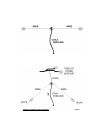
RAMSEY DA SERIES DIPOLE ANTENNA Page 5
HOW DOES A DIPOLE ANTENNA WORK?
A dipole antenna is a long wire that is suspended between two points. The
wire is cut to a specific length, and is fed in the middle with a radio frequency
(RF) signal. One half of the antenna is hooked to the ground wire of the
transmission line, and the other is hooked to the center conductor.
As an RF signal is applied to a piece of wire, both an electric and a
magnetic field is set up around the wire. These waves propagate through
the air (or ether!) without limit. As these magnetic and electric fields reach
another station’s antenna (or about any other metal object in it’s path) the
exact reverse effect takes place on our antenna that our RF signal did. The
rapidly changing fields produce an RF current that your receiver can detect.
Although it is impossible to actually see the waves coming off of a dipole,
we can try to visualize it to understand it better. Take a piece of paper and
push a pen or pencil through the center. Hold it up in front of you. Let’s
pretend that the pencil represents our antenna, and the paper represents
where our signal is concentrated. As you can see, most of the radiation is
given off at a 90 degree angle to the antenna, with very little radiation
occurring parallel to the pencil. It is this property that makes the dipole
directional. Another advantage is that the radiation is at all angles around
the wire, and the signal has a maximum chance to skip through the
atmosphere, making the dipole ideal for DX.
An inverted dipole does have a number of advantages over typical dipoles.
For one thing, they take up less space, with some of their wire being used up
to climb a vertical distance, and a five percent reduction in antenna length
over a normal dipole. They also match their impedance more easily to a 50
ohm coaxial cable than a typical dipole, which has an impedance of 65
ohms. The inverted dipole also has a higher angle of radiation — making it
better for sky wave DX.
If you have any questions, we suggest that you look for the ARRL Handbook,
which has all sorts of great information for hanging antennas.


















